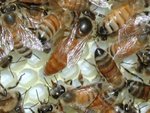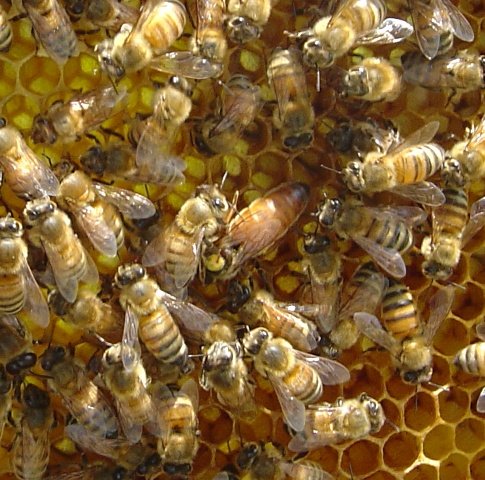It has been a very difficult beekeeping season for me. We started the winter with nine very strong colonies with young queens. By May we were down to four. That’s over a 50% loss of hives. Of those four, one is very weak, two are average, and one is extremely strong.

Left: A dead hive. This hive was lead by one of the queens I raised last summer. Most of the time you can never figure out what happened. This hive stayed in the bottom box and never moved up to the upper box where there was plenty of honey and candy feed. They starved to death inches away from abundant supply
.
.
.
.
That’s beekeeping. Everything was picture perfect in the fall, by spring the story changes.
Of the six queens I raised last year, only two have survived. One survivor was given to a local beekeeper last fall. The other is leading the week colony in our bee yard.

Left: A cell builder hive with two cell cup holding frames installed. These bees do not have a queen, and will quickly turn the grafted cells into queen cells.
.
.
.
.
.
.
.
.
The honey flow is occurring here on Cape Cod, it started about two weeks ago. The bees are quickly storing nectar in the cells, ripening it into honey.
I have been watching my colonies closely for signs of swarming. So far all I have seen are queen cell cups, the cells that queens could be raised in. There have been no attempts by the bees to swarm this year. I have found that if you stay ahead of the bees, and provide them with young queens (introduced in the fall), and plenty of room ahead of schedule, they stay contented in their hives.
I have had no signs of disease or mites in any of the colonies this spring. That’s encouraging. You can see from past blog posts that last year we battled the worst infestation of verroa mites I have ever seen. It is interesting to note that the worst infested hives last year are the strongest this year, even though all the hives were treated.

Right: A frame of young eggs and larva from my strong hive. These young female larva are the offspring from my strongest queen. I want more queens like her.
.
.
.
With swarm season on, we received our first call to collect a wild swarm of bees from the local conservation area. The swarm was hanging off of the corner of a picnic table. You can’t find an easier location than that!. We just put a hive under them, and they dropped right in. This will help make up our winter losses.

Right: Some of the 75 grafted queen cups I made today. They were installed into the cell builder shortly after this picture was taken.
.
.
.
With swarm season on, it is time to try my hand at queen rearing again.
Last week I set up a “Cell Builder” hive. A cell builder is a queenless hive which contains emerging bees, nurse bees, brood, pollen, and nectar. In other words a strong young hive which does not have a queen. Since they do not have a queen, and no young larva to use to raise a queen, they will be primed for my grafts. Grafting is a method of queen rearing where you transfer four day old larva into special cells. These special cells are then built into queen cells by the bees.
Today I inspected all the hives, took young larva from my strong hive, and graft 75 cells cups. These cell cups were then installed into the cell building hive. I’m sure the bees were happy to see the young larva, and have the opportunity to raise some queens.

Left: A closeup of the grafts. You can see the small 4 day old larva floating on a layer of royal jelly.
.
In 24 hours I can look to see how many of the larva they accepted, and decided to grow into queens.







very good work
ReplyDeletekolay gelsin arıcı 07 Hayati İnal ANTALYA
ReplyDelete